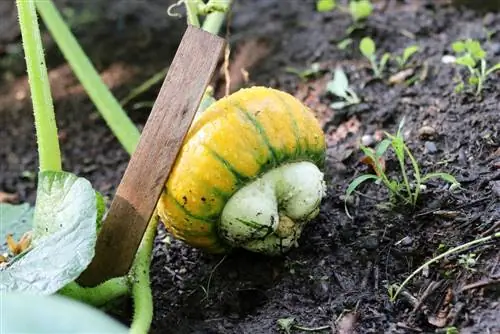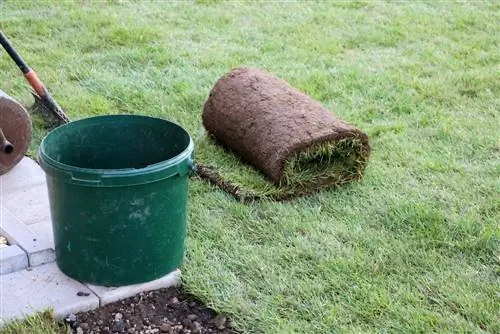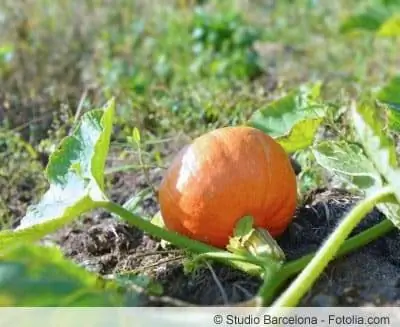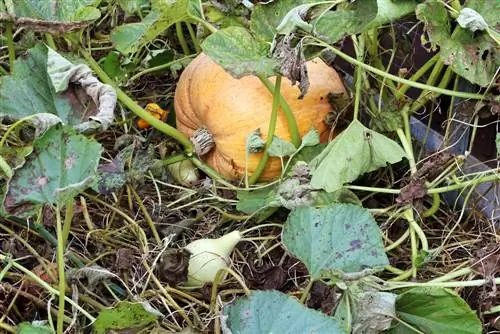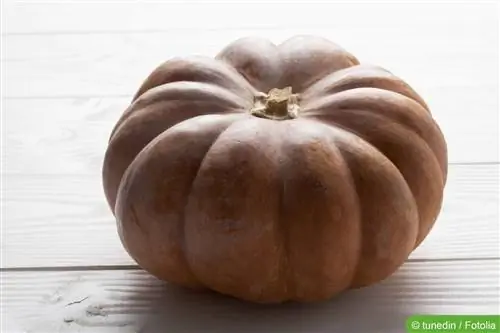- Author admin [email protected].
- Public 2023-12-17 03:39.
- Last modified 2025-06-01 06:48.
It is considered a feast for the senses, because a bishop's cap impresses with its sublime shape combined with aromatic pulp. This type of pumpkin therefore exceeds the function of a typical ornamental pumpkin, which is generally not edible. A Turkish turban pumpkin lives up to its striking title, because no one can escape the magic of its flat, rounded silhouette with the decoratively drawn bulge in the middle. Find out here how to grow and prepare it professionally.
Cultivation starts with indoor cultivation
Considering a ripening time of around 100 days, we recommend sowing behind glass when growing a bishop's cap. Using this strategy gives the pumpkin an extended cultivation time of up to 3 weeks. The second half of April is the ideal time to sow pumpkin seeds. By mid-May, the young plants have matured to such an extent that they can be planted out with a considerable growth advantage. How to proceed:
- Roughen the strong seeds a little with a file or sandpaper.
- Then let it soak in lukewarm water for 24 hours.
- Fill cultivation pots with lean substrate.
- Insert 2-3 pumpkin seeds each 2 cm deep and moisten.
- Cover the seed containers with glass, cover them with foil or put them in the greenhouse.
- Set up in a partially shaded place at a constant 25 °C.
Germination begins within a week, recognizable by the two cotyledons. Slightly cooler temperatures around 20-22 °C are an advantage. The cover is removed because the seedlings are growing at a considerable rate. The substrate is kept slightly moist during this time. To ensure that the sensitive roots are not damaged, experienced hobby gardeners avoid traditional pricking. Instead, the weakest specimens are sorted out.
Location and soil conditions
The time window for outdoor cultivation opens in mid-May. In order for the cultivation of a bishop's hat to proceed as desired, the focus is now on choosing the location. A Turk's Turban pumpkin thrives under the following conditions:
- sunny, warm location, preferably a little breezy
- nutrient-rich, humus-rich soil, permeable and loose
- fresh-moist and not too dry
- ideal is a pH value of 6.5 to 7
- no other pumpkins, melons or cucumbers in pre-culture
Knowledgeable hobby gardeners choose the compost heap as the location because this is where heavy feeders find an optimal environment. This gardening trick significantly reduces the amount of care required, while the visual appearance of a rot is decoratively enhanced.
Tip:
In the small garden, a location directly next to the chain-link fence is ideal for the bishop's hat. The long tendrils can be tied up here so that they take up less space.
Plants
Once you have decided on the location, prepare the bedding soil for the Turk's turban pumpkin. Beforehand, place the root ball of the young plant in a container with water so that it can soak up moisture. This is how you plant the bishop's hat correctly:
- Weed the soil thoroughly and loosen it thoroughly.
- Optimize the soil quality with plenty of compost and horn shavings.
- Dig a planting hole with twice the volume of the root ball.
- Create a drainage system at the bottom of the pit made of gravel or pottery shards.
- Insert the potted pumpkin plant, press down the soil and water well.
- A planting distance of 100 to 150 centimeters is considered appropriate.
Since the thermometer can still fall into unfavorable ranges until June when the sheep are cold, it is advisable to use a protective film in the bed for the first time. The growing Turk's turban pumpkin should be protected at least during the night.
Care
With the choice of a suitable location and professional planting, two significant prerequisites for the successful cultivation of a bishop's cap are created. The subsequent care revolves around the following factors:
- water in a balanced manner, allowing the soil surface to dry between waterings
- fertilize the bishop's hat organically with compost every 14 days
- A 2-3 cm thick layer of mulch keeps the soil warm and moist
Since cucurbits are at the top of the menu for slugs, professional care always goes hand in hand with protection against the voracious pests. A snail fence works wonders here to keep the pest away. A traveling barrier made of materials such as chippings or wood chips also proves to be effective. Surround the bishop's hat regularly with a ring made of coffee grounds or coffee grounds, as the caffeine has a toxic effect on snails.
Tip:
If you shorten the long shoots in June and July to just a few flowers with fruit, you will get larger bishop's hats.
Harvest
If everything goes according to plan, the harvest time for the Turk's turban pumpkin will begin in September. You can recognize a ripe fruit by its woody fruit stem and a firm shell. In addition, there should no longer be any green spots visible. If after knocking there is a hollow and muffled sound from inside the fruit, nothing stands in the way of a harvest. Cut the bishop's hat so that 5-10 cm of the stem remains on the cover. This way you ensure that no rot or pests get into the pumpkin.
Preparation
The juicy flesh of the Turk's turban pumpkin is a popular ingredient for a variety of creative recipes for soups and meat-based fillings. The hard shell, on the other hand, is not suitable for consumption. Since it is far too good to simply be peeled off, chefs like to use the casing of a bishop's cap as a tureen. The following recipe should serve as a suggestion for preparation:
- Cut the lid off the Turk's turban pumpkin and set aside.
- Scrape out the pulp with a spoon and put it in a pot.
- Brush the bishop's hat with olive oil.
- Braise in the preheated oven for 30 minutes at 200 degrees.
- Prepare the pumpkin meat according to a recipe of your choice as a soup or filling.
- Fill the food into the pumpkin and finish baking in the oven.
Served in this spectacular way, you are sure to gain the admiration of your guests as both a creative chef and a talented gardener.
Conclusion
The spectacularly shaped bishop's hat promises multiple pumpkin fun. Easy to handle in cultivation and decorative in appearance, it surpasses any typical ornamental pumpkin because its flesh is suitable for consumption. Smart hobby gardeners simply plant the Turk's turban pumpkin on the compost heap and thus reduce the maintenance effort to a minimum. Following the harvest in autumn, the beautiful pumpkin enriches the home kitchen with its aromatic and he althy pulp. This is where the bishop's hat once again scores points, as it not only provides the main ingredient for preparing delicious soups and fillings, but also serves as a unique terrine.
What you should know about the bishop's hat in brief
Special features
- The bishop's hat is not only a very decorative but also a tasty pumpkin.
- The multicolored ornamental pumpkin bears turban-like fruits and is therefore called the Turk's turban or bishop's hat.
- The pumpkin is one of the oldest cultivated plants on earth.
- The fruit vegetable is an annual and produces both male and female flowers on one plant.
- The flowers are pollinated by bees and bumblebees.
- Botanically speaking, pumpkin is a berry fruit like oranges, bananas and tomatoes.
- The original wild pumpkin is not edible due to its bitter substances.
- By cultivating numerous varieties, the bitter substance has been bred back, which makes the pumpkin a tasty vegetable plant.
- The three largest types include the Pepo, Maxima and Moschata pumpkins.
Types of pumpkins
- There are countless types of pumpkin and new varieties are constantly being added.
- Acon, butternut, turban, musk and yellow quinoa are winter squashes.
- They have a hard shell that is not suitable for consumption.
- Winter squashes can be stored in cool places for several months.
- Summer squashes have soft shells, such as zucchini, crooknecks, patissons and spaghetti squash.
- They can be stored for a maximum of three to six weeks.
- Ornamental pumpkins are wild pumpkin species. You cannot eat them because they contain unpleasant bitter substances.
- Decorative pumpkins are extremely decorative and are ideal for autumn decoration of the house, yard and garden.
- Pumkins are types of pumpkins that are particularly suitable for carving: including the yellow hundredweight pumpkin, the Halloween pumpkin and the spooktacular.
Bishop’s hat - cultivation
- Pumpkins need sufficient nutrients, water and sun.
- Growing pumpkin plants is relatively easy.
- From mid-May, after the Ice Saints, you can sow the pumpkin seeds directly in the outdoor bed.
- When pre-cultured in pots, the pumpkins can be harvested three to four weeks earlier.
- One pumpkin seed per pot is completely sufficient and saves pricking out later.
- The potting soil is loosened well and enriched with compost.
- Since the seeds now need heat, the pots are covered with foil or fleece.
- Then you cut ventilation slots in the film so that the soil doesn't rot.
- The pumpkin plants need a lot of water throughout the entire cultivation period and should therefore be watered regularly and evenly.
- The first pumpkins are harvested just six weeks after planting and eight weeks after direct sowing.
- Winter squashes are allowed to fully ripen and are not removed until late summer, while summer squashes should not get too large.
The pumpkin and its positive properties
The pumpkin has a variety of positive properties and is therefore very he alth-promoting. The pumpkin pulp is rich in fiber, which stimulates intestinal activity and has a positive effect on digestion. Pumpkin juice contains important minerals such as magnesium, copper, iron and potassium as well as all vitamins. Pumpkins also have a diuretic effect and thus support the breakdown of fat deposits. The pumpkin seed oil obtained lowers cholesterol levels and also strengthens the immune system.

